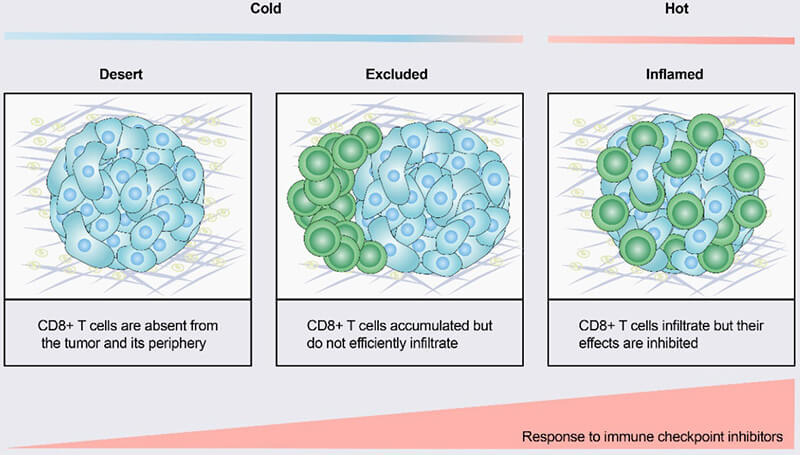The tumor microenvironment (TME) serves as the internal space for tumor cell growth and progression. Contrary to traditional viewpoints, we now perceive the TME as a complex integrated system. This system comprises cellular components such as tumor cells and inflammatory/immune cells. Non-cellular components like the extracellular matrix (ECM) and cytokines are also part of it. During cancer development, the TME isn’t simply a passive observer but an active promoter of cancer progression.
Based on the growth characteristics, tumors can be divided into “malignant” and “benign”. According to the spatial distribution of immune cells in TME, tumors can be classified into three basic immunophenotypes: immune-inflamed, immune-excluded, and immune-desert phenotypes.
“Hot” and “cold” tumors
Firstly, “Hot tumors”, also known as immune-inflamed tumors, stand out due to high T-cell infiltration. They also show increased interferon-γ (IFN-γ) signaling and expression of PD-L1. Secondly, these tumors carry a high tumor mutational burden (TMB). Typically, a higher TMB leads to more neoantigens that T cells can recognize, turning these tumors into prime candidates for activating the immune system. A vital player in this scenario is CD8+ T lymphocytes. They play significant roles in extending cancer patients’ survival and enhancing immunotherapy’s efficacy. Moreover, the infiltration of these CD8+ T lymphocytes is a critical factor for the success of cancer immunotherapies.
On the flip side, we have what are termed “cold tumors”. These include immune-excluded and immune-desert tumors. In immune-excluded tumors, CD8+ T lymphocytes are found only at invasion margins and they fail to infiltrate the tumor efficiently. Lastly, in immune-desert tumors, CD8+ T lymphocytes are totally absent, not just from the tumor but also its periphery.
Cold tumors exhibit immunosuppressive mechanisms of the TME: Apart from showing poor T cell infiltration, these cold tumor TMEs may inhibit T cell priming. Furthermore, the deposition of ECM and stiff stroma-induced hypoxia in cold tumor lesions build a physical and chemical barrier to obstruct the T cell infiltration. Most notably, a plethora of immunosuppressive cells populate the TME of cold tumors and they dampen the function of CD8+ T cells through inducing T cell exhaustion.
In summary, TME in cold tumors lacks innate immunity, or “cold tumors” possess innate anti-tumor immunity characteristics.
References:
[1] Yuan-Tong Liu, et al. 2021 Mar 11;11(11):5365-5386.
[2] Bagher Farhood,et al. J Cell Physiol. 2019 Jun;234(6):8509-8521.
